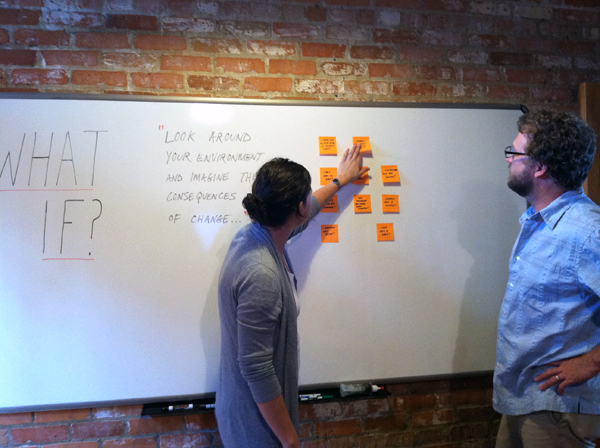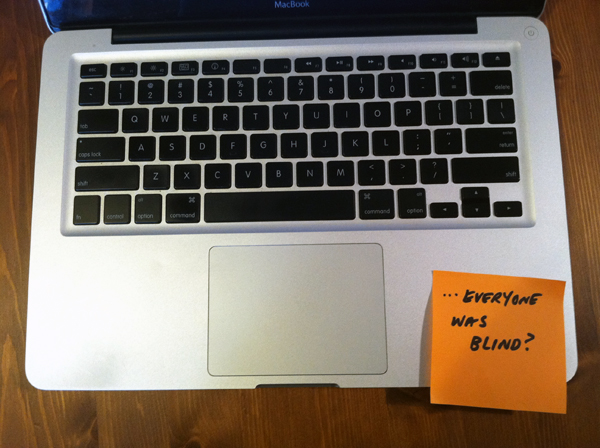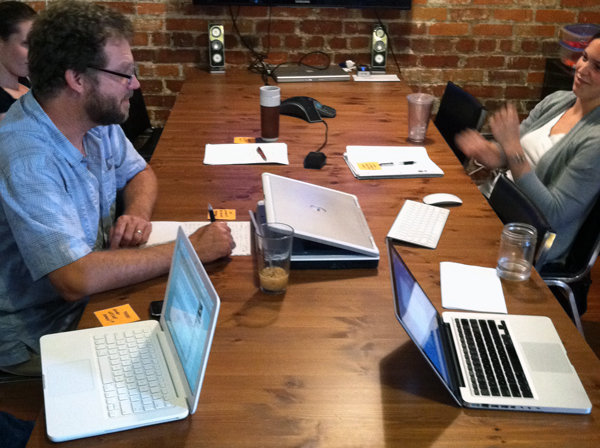This week I was listening to a podcast from PRI’s To the Best of Our Knowledge, which was focused on the creative mind. One segment in particular inspired me. At roughly the 15-minute mark (15:11 – 24:20), Anne Strainchamps begins an interview with Shelley Carson, a Harvard psychologist who does research on creativity and the brain. Through her study, Carson has developed methods for amplifying creativity—something she believes is necessary to all walks of life and that everyone has equal capacity to practice. As I listened to the interview, I realized how helpful her point of view could be to anyone struggling with the creative side of maintaining their content marketing strategy. Stick with me…
Your Brain is Creative
Carson believes that the human brain has 7 different patterns for creative thinking. She calls these “brainsets,” a play on the word we often use to describe our volitional thinking—mindsets. Brainsets are what she considers the biological equivalent of mindsets. One brainset in particular struck me as helpful to those who find writing difficult. Here’s Carson:
“Another brainset is the ‘Envision’ brainset, and in this brainset you’re thinking visually rather than verbally and you’re able to see and manipulate objects in your mind’s eye. When you do this, you see patterns emerge and you tend to think metaphorically–all of the sudden you’ll see comparisons between two things that seem very far removed from each other ordinarily.”
This sounds like a perspective that is probably easily accessible to the kinds of people we work with all the time—visual thinkers who work in the “creative” industries. To hone the “Envision” brainset, Carson described an exercise that she uses to help people engage with it, one she calls What If? After listening to her describe it, I thought it would make a great exercise for our weekly internal enrichment session—and hopefully also for anyone reading this—so I set a few things up in our conference room so our client services team could try it out for themselves.

First, we listened to the podcast segment together. Then, we started the exercise. Here’s how it works:
Exercise: What if…?
The idea behind exploring “what ifs” is to get us to look around our environment and imagine the consequences of change. Carson listed off some of the prompts that she uses, asking people to imagine: What if…
- …the sky was green?
- …trees hung upside down?
- …humans had 3 arms instead of 2?
- …cockroaches ran for Senate?
I wrote down each of these prompts on post-it notes, and stuck them to the whiteboard in the room. I planned to have each person choose a prompt to follow, so I needed to add a few to make sure there were plenty to choose from. I came up with these:
- …the continents had never separated?
- …everyone was blind?
- …light had a scent?
- …cars ran on dirt?
- …the telephone had never been invented?
- …digestion took 5 minutes?
- …people preferred to eat insects?
- …there was no such thing as straight lines?

Once everyone had chosen a prompt, I instructed the group to spend the next five minutes freewriting in response. I’ll share some of the responses below. But first, here’s Carson on the cognitive benefit of doing an exercise like this one:
“When you start imagining this and actually seeing it in your mind’s eye and seeing all these different consequences that might occur, this is not a trivial or a silly exercise. When you do it you’re actually forging pathways in the brain that will allow you to activate this envision brainset more easily in the future…As we mature, our prefrontal cortex matures. And this is the part of the brain that’s discerning. It helps us to plan for the future, but it does that by judging the information that’s being given to it from the rest of the brain. So as we go through life, what we do is we filter out more and more information so we can increase the signal to noise ratio in our brains and pretty soon, we’re only aware of stimuli that is part of our particular goals for the current time, our current task at hand, or for our survival. But we actually filter this information out. We literally don’t see it, hear it, or feel it because it’s not conducive to accomplishing our current goals. Kids don’t have this level of prefrontal cortex development yet, so they’re still getting all this information and wondering about it. This is one of the things we want to do when we’re being creative, or at least during a portion of the creative process. We want to turn down that prefrontal cortex evaluator and allow more information to filter in to our conscious awareness.”
Carson’s explanation is helpful to understanding why we find practicing creative thinking such a challenge, and why we tend to believe that only some people are creative. I think she makes a good case to the contrary, and after reading the responses that our team created in our enrichment session, it seems validated to me.

What Does This Have to Do With Content Strategy?
So, why is this important? Well, because writing is difficult, not to mention writing well (which requires different kinds of thinking and different types of approaches) and often. This is the challenge that anyone responsible for content strategy leadership, management or content creation faces all the time. It is especially a challenge for those who have been creating content for a while and feel like they’re running out of ideas. Exercises like this one are useful in extracting responsive creativity even when you think you’re fresh out. We explored another idea like this one recently—The Two Things—which inspired our team to produce their own versions. “The two things about…” posts in response (about content, website measurement, SEO, scheduling, lead generation, and web design) were plentiful!
Good writing requires regular writing. Think of any article you might write as race you might run. Competitive runners spend most of their time running, alone, when nobody else sees them in order to condition their bodies to be able to perform those comparatively few times they need them to. Writing—good writing—requires that same ratio of practice to performance. As we did the exercise, I imagined that if we all transitioned into writing specific articles on topics relevant to what Newfangled does, we’d be able to get into them much more quickly and produce better pieces than had we not exercised our creativity first.
But, stepping back even further, I truly believe that any successful content strategy, especially over the long term, will depend heavily upon an internal culture that invests time and resources in enrichment and educational experiences, just like the one I described in this post. One result of making these kinds of experiences common should be in maintaining the flow and quality of content, but another will be manifest in the growth of the people creating that content. They’ll be smarter, more perceptive, and better at communicating the ideas that are central to what you do.
Some of the Group’s Responses
I took notes on these as people read theirs aloud, so their very creative and articulate paragraphs have been transformed into not-as-impressive bullet points, but you’ll get the idea. Here are a few of them:
What if cockroaches ran for Senate? Steve answered:
- they’d be intelligent, walking upright, living along with humans
- humans might have been in a great period of war with the cockroaches but then united
- different groups of humans can’t share dominance very well
- would they be mostly democrats or republicans?
What if light had a scent? Lauren answered:
- there wouldn’t be a need for air fresheners in homes, unless only natural light had a scent
- houses would be decorated by scent
- electricity costs would go up because people would enjoy smelling the light
- there’d be a market for bad smelling lights that introverts could buy to discourage visitors or trick-or-treaters
What if digestion took 5 minutes? Katie answered:
- we’d never eat like we do now
- we’d have an IV and become unaware of eating like how we feel about breathing
- getting nutrition would be a bodily annoyance and treated like we treat things like body odor
What if the sky was green? Lindsey answered:
- the oceans would probably be green
- would land be blue?
- maps would be weird
- blue would probably not be as popular a color as it is now
- sky blue and carolina blue would be gone
- art would be different (no starry night, etc.)
What if the continents had never separated? I answered:
- The first thing I think of would be there would be far less maritime culture. Much of it began through a desire to explore, so a world in which there are no other continents wouldn’t require boats to reach those places. Of course, at such an early stage, the inhabitants of Pangea wouldn’t necessarily know that those boats aren’t necessary. But it the continents had never separated, the immediate geographic boundaries that segregated culture and languages would probably not have been as strong. Maybe there would have been only one language. Of course, there surely would have been other geographic barriers, like mountains and deserts, that might divide up cultures in ways similar to how oceans have in our own universe. In fact, it might be true that in a world with only one continent, trade would be far more challenged. In a multi-continent world, trade from two very distant places could be encouraged by having natural stops along the way, whereas a trip from one side of Pangea to another might be far too arduous to be done very often, making goods unique to each place far more valuable. I also just thought of the idea that if the continents had never separated, there would probably be far less seismic activity on the planet, preventing many of the disasters we’ve known in human history. I don’t know enough about geology, but that would probably have to mean a much different crust–maybe one that is much thicker and therefore produces very different kinds of plants and minerals.
There were many more good responses. We had fun.



